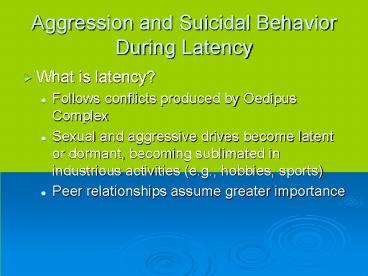Aggression and Suicidal Behavior During Latency - PowerPoint PPT Presentation
1 / 14
Title:
Aggression and Suicidal Behavior During Latency
Description:
Follows conflicts produced by Oedipus Complex. Sexual and aggressive drives become latent or dormant, ... Casual minimizing or dismissing of attachment needs ... – PowerPoint PPT presentation
Number of Views:34
Avg rating:3.0/5.0
Title: Aggression and Suicidal Behavior During Latency
1
Aggression and Suicidal Behavior During Latency
- What is latency?
- Follows conflicts produced by Oedipus Complex
- Sexual and aggressive drives become latent or
dormant, becoming sublimated in industrious
activities (e.g., hobbies, sports) - Peer relationships assume greater importance
2
Problems during Latency
- Conflicts from the Oedipal period as well as
earlier periods (oral, anal periods) are poorly
resolved or not resolved at all - Attachment insecurities assume different forms
- secure confidence in relationships,
goal-corrected partnership, autonomy - Casual minimizing or dismissing of attachment
needs - Busy distracting oneself from affective
components of attachment through activity or
displacement of fears onto others (projection,
reaction formation) - Controlling
- Punitive
- Caregiving
3
- Resulting symptomatologyaggression or depression
- Possible etiologies
- Wants to hurt others because not Oedipal victor,
not in control of parents (anal), or not getting
basic security needs met (oral) - Wants to hurt self because of guilty feelings
over being Oedipal victor, fantasies of having
destroyed mother (oral), need to destroy internal
representation of mother or father, need to
activate caregivers concern
4
Attachment Disorganization In Prepubertal
Psychiatric Inpatients
- Three traditional patterns of attachment (A, B,
C) - Fourth category (D)
- Four proposed subtypes of Dlooking for
organization within disorganization - Direct-aggressive outward
- Direct-aggressive inward
- Indirect-aggressive pseudosecure
- Indirect-aggressive displaced
5
- Each attachment pattern subtype is coherently
related to both psychiatric diagnosis and
clinical symptomatology, as well as to what we
know about the relationship to the mother (but
diagnosis and symptomatology can imply other
pathways) - Each child had experienced significant separation
from a significant or primary caregiver
6
- Psychotic features could be related to
disturbances in the attachment relationship
(difficulties with separation) - Is the disorganization attachment-relevant, or
more global psychosis? - Is the disorganization attachment-relevant, or
more neurologically based? - Could florid psychotic features (in subtype 1 and
2) develop into more reality-based
disorganization (in subtypes 3 and 4)?
7
Effects of Attachment Disorganization during
Latency I (Solomon et al.)
- Children who appear controlling upon reunion
appear frightened (chaotic or inhibited) in story
completions - Frightened children appear more aggressive at
home and more hostile at school then children
with organized attachment strategies - Development of coding system related to
development sample (p. 460, 2nd column)
8
- 6/13 D, 4/27 non-D fell into highest quartile on
CBCL - 7/11 D, 4/29 non-D fell into lowest quartile of
ISCS
9
Effects of Attachment Disorganization During
Latency II (Easterbrooks et al.)
- Do attachment security and verbal intelligence
moderate the effects of psychosocial risk on
behavioral adaptation (aggression in classroom)? - How psychosocial risk is measured
- Family income
- AFDC status (welfare)
- Maltreatment reports to DSS
- Law enforcement problems during past two years
- Serious injuries or hospitalization of child
during past two years - Maternal depression (CES-D) 16 (clinical
cutoff) - Sum sum of yes scores to all six areas
(composite risk)
10
- Correlation matrix
- Risk related to attachment security (p lt .05)
- Risk not related to attachment avoidance (n.s.)
- Risk marginally related to verbal intelligence (p
lt.10) - Attachment security related to verbal
intelligence (p lt.05) - Attachment avoidance related to verbal
intelligence (p lt.05) - Attachment security related to attachment
avoidance (p lt.001) - Risk related to externalizing, total behavior
problems - Attachment security related to internalizing,
externalizing, total behavior problems - Attachment avoidance related to internalizing,
externalizing, total behavior problems - Verbal intelligence not related to behavior
problems
11
- Predictions (RAVRARV ? behavior problem)
- Risk predicted externalizing and total problems
in both mother and father reports - Attachment security predicted internalizing,
externalizing, and total problems, but only in
teacher reports - No interaction effects in behavior-problems
analyses - Verbal intelligence did not predict behavior
problems - Insecure attachments more likely to appear in
clinical range than secure attachments (88 vs.
45, 100 controlling)
12
Suicidal Behavior During Latency
- Maternal suicidal ideas and gestures (severity)
related to childs treatment status (p lt .01) - Prevalence of diagnosis
- Inpatient conduct disorder, MDD, Organic Brain
Syndrome, PDD, Schizophrenia, BPD - Outpatient adjustment disorder
- Nonpatient anxiety disorder
13
- Variables associated with suicidal behavior
- Recent general psychopathology
- Preoccupation with death
- Recent and past depression
- Introjection (inpatient, nonpatient)
- Past general psychopathology
- Recent aggression (outpatient)
14
(No Transcript)



























![T. Lau, MD, FRCPC [psych], MSc., Assistant Professor, Faculty of Medicine, UNIVERSITY OF OTTAWA PowerPoint PPT Presentation](https://s3.amazonaws.com/images.powershow.com/6670543.th0.jpg?_=20150601120)



